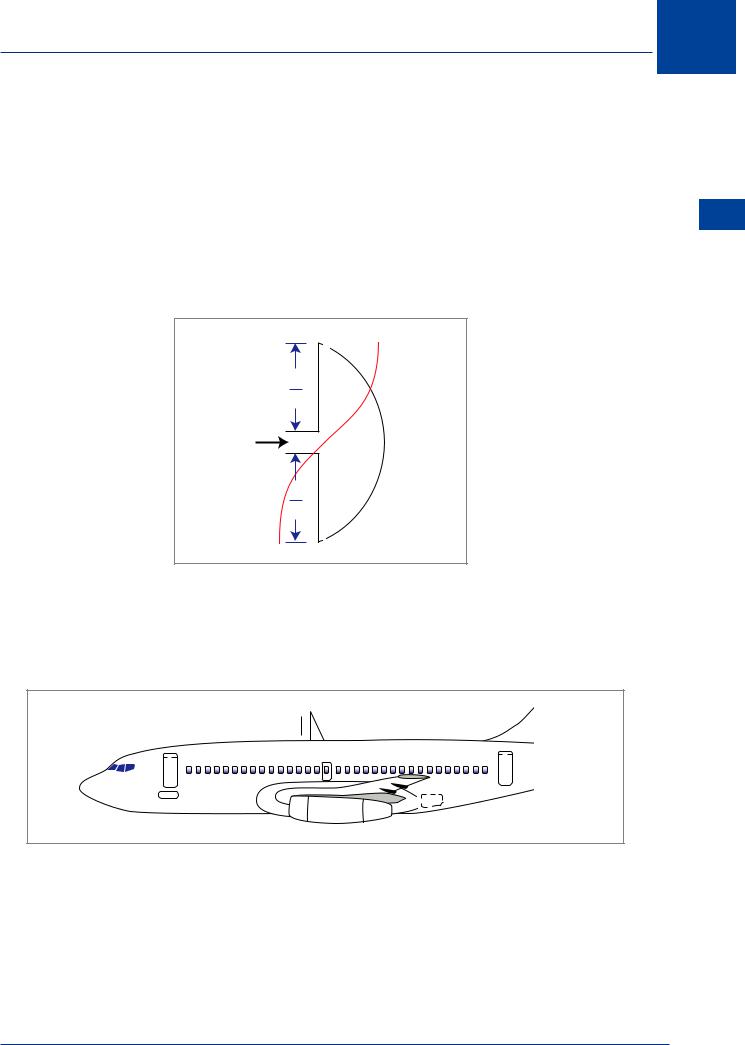
- •Textbook Series
- •Contents
- •1 Properties of Radio Waves
- •Introduction
- •The Radio Navigation Syllabus
- •Electromagnetic (EM) Radiation
- •Polarization
- •Radio Waves
- •Wavelength
- •Frequency Bands
- •Phase Comparison
- •Practice Frequency (
- •Answers to Practice Frequency (
- •Questions
- •Answers
- •2 Radio Propagation Theory
- •Introduction
- •Factors Affecting Propagation
- •Propagation Paths
- •Non-ionospheric Propagation
- •Ionospheric Propagation
- •Sky Wave
- •HF Communications
- •Propagation Summary
- •Super-refraction
- •Sub-refraction
- •Questions
- •Answers
- •3 Modulation
- •Introduction
- •Keyed Modulation
- •Amplitude Modulation (AM)
- •Single Sideband (SSB)
- •Frequency Modulation (FM)
- •Phase Modulation
- •Pulse Modulation
- •Emission Designators
- •Questions
- •Answers
- •4 Antennae
- •Introduction
- •Basic Principles
- •Aerial Feeders
- •Polar Diagrams
- •Directivity
- •Radar Aerials
- •Modern Radar Antennae
- •Questions
- •Answers
- •5 Doppler Radar Systems
- •Introduction
- •The Doppler Principle
- •Airborne Doppler
- •Janus Array System
- •Doppler Operation
- •Doppler Navigation Systems
- •Questions
- •Answers
- •6 VHF Direction Finder (VDF)
- •Introduction
- •Procedures
- •Principle of Operation
- •Range of VDF
- •Factors Affecting Accuracy
- •Determination of Position
- •VDF Summary
- •Questions
- •Answers
- •7 Automatic Direction Finder (ADF)
- •Introduction
- •Non-directional Beacon (NDB)
- •Principle of Operation
- •Frequencies and Types of NDB
- •Aircraft Equipment
- •Emission Characteristics and Beat Frequency Oscillator (BFO)
- •Presentation of Information
- •Uses of the Non-directional Beacon
- •Plotting ADF Bearings
- •Track Maintenance Using the RBI
- •Homing
- •Tracking Inbound
- •Tracking Outbound
- •Drift Assessment and Regaining Inbound Track
- •Drift Assessment and Outbound Track Maintenance
- •Holding
- •Runway Instrument Approach Procedures
- •Factors Affecting ADF Accuracy
- •Factors Affecting ADF Range
- •Accuracy
- •ADF Summary
- •Questions
- •Answers
- •8 VHF Omni-directional Range (VOR)
- •Introduction
- •The Principle of Operation
- •Terminology
- •Transmission Details
- •Identification
- •Monitoring
- •Types of VOR
- •The Factors Affecting Operational Range of VOR
- •Factors Affecting VOR Beacon Accuracy
- •The Cone of Ambiguity
- •Doppler VOR (DVOR)
- •VOR Airborne Equipment
- •VOR Deviation Indicator
- •Radio Magnetic Indicator (RMI)
- •Questions
- •In-flight Procedures
- •VOR Summary
- •Questions
- •Annex A
- •Annex B
- •Annex C
- •Answers
- •Answers to Page 128
- •9 Instrument Landing System (ILS)
- •Introduction
- •ILS Components
- •ILS Frequencies
- •DME Paired with ILS Channels
- •ILS Identification
- •Marker Beacons
- •Ground Monitoring of ILS Transmissions
- •ILS Coverage
- •ILS Principle of Operation
- •ILS Presentation and Interpretation
- •ILS Categories (ICAO)
- •Errors and Accuracy
- •Factors Affecting Range and Accuracy
- •ILS Approach Chart
- •ILS Calculations
- •ILS Summary
- •Questions
- •Answers
- •10 Microwave Landing System (MLS)
- •Introduction
- •ILS Disadvantages
- •The MLS System
- •Principle of Operation
- •Airborne Equipment
- •Question
- •Answer
- •11 Radar Principles
- •Introduction
- •Types of Pulsed Radars
- •Radar Applications
- •Radar Frequencies
- •Pulse Technique
- •Theoretical Maximum Range
- •Primary Radars
- •The Range of Primary Radar
- •Radar Measurements
- •Radar Resolution
- •Moving Target Indication (MTI)
- •Radar Antennae
- •Questions
- •Answers
- •12 Ground Radar
- •Introduction
- •Area Surveillance Radars (ASR)
- •Terminal Surveillance Area Radars
- •Aerodrome Surveillance Approach Radars
- •Airport Surface Movement Radar (ASMR)
- •Questions
- •Answers
- •13 Airborne Weather Radar
- •Introduction
- •Component Parts
- •AWR Functions
- •Principle of Operation
- •Weather Depiction
- •Control Unit
- •Function Switch
- •Mapping Operation
- •Pre-flight Checks
- •Weather Operation
- •Colour AWR Controls
- •AWR Summary
- •Questions
- •Answers
- •14 Secondary Surveillance Radar (SSR)
- •Introduction
- •Advantages of SSR
- •SSR Display
- •SSR Frequencies and Transmissions
- •Modes
- •Mode C
- •SSR Operating Procedure
- •Special Codes
- •Disadvantages of SSR
- •Mode S
- •Pulses
- •Benefits of Mode S
- •Communication Protocols
- •Levels of Mode S Transponders
- •Downlink Aircraft Parameters (DAPS)
- •Future Expansion of Mode S Surveillance Services
- •SSR Summary
- •Questions
- •Answers
- •15 Distance Measuring Equipment (DME)
- •Introduction
- •Frequencies
- •Uses of DME
- •Principle of Operation
- •Twin Pulses
- •Range Search
- •Beacon Saturation
- •Station Identification
- •VOR/DME Frequency Pairing
- •DME Range Measurement for ILS
- •Range and Coverage
- •Accuracy
- •DME Summary
- •Questions
- •Answers
- •16 Area Navigation Systems (RNAV)
- •Introduction
- •Benefits of RNAV
- •Types and Levels of RNAV
- •A Simple 2D RNAV System
- •Operation of a Simple 2D RNAV System
- •Principle of Operation of a Simple 2D RNAV System
- •Limitations and Accuracy of Simple RNAV Systems
- •Level 4 RNAV Systems
- •Requirements for a 4D RNAV System
- •Control and Display Unit (CDU)
- •Climb
- •Cruise
- •Descent
- •Kalman Filtering
- •Questions
- •Appendix A
- •Answers
- •17 Electronic Flight Information System (EFIS)
- •Introduction
- •EHSI Controller
- •Full Rose VOR Mode
- •Expanded ILS Mode
- •Full Rose ILS Mode
- •Map Mode
- •Plan Mode
- •EHSI Colour Coding
- •EHSI Symbology
- •Questions
- •Appendix A
- •Answers
- •18 Global Navigation Satellite System (GNSS)
- •Introduction
- •Satellite Orbits
- •Position Reference System
- •The GPS Segments
- •The Space Segment
- •The Control Segment
- •The User Segment
- •Principle Of Operation
- •GPS Errors
- •System Accuracy
- •Integrity Monitoring
- •Differential GPS (DGPS)
- •Combined GPS and GLONASS Systems
- •Questions
- •Answers
- •19 Revision Questions
- •Questions
- •Answers
- •Specimen Examination Paper
- •Appendix A
- •Answers to Specimen Examination Paper
- •Explanation of Selected Questions
- •20 Index

Chapter
4
Antennae
Introduction |
|
|
|
|
|
|
55 |
Basic Principles . . . . . . . . . . . . |
. . . . . . |
. . |
. . |
. . |
. . . . |
. |
55 |
Aerial Feeders |
|
|
|
|
|
|
56 |
Polar Diagrams . . . . . . . . . . . . |
. . . . . . |
. . |
. . |
. . |
. . . . |
. |
57 |
Directivity . . . . . . . . . . . . . . |
. . . . . . |
. . |
. . |
. . |
. . . . |
. |
58 |
Radar Aerials . . . . . . . . . . . . |
. . . . . . . |
. . |
. . |
. . |
. . . . |
|
. 60 |
Modern Radar Antennae |
|
|
|
|
|
|
61 |
Questions . . . . . . . . . . . . . . |
. . . . . . |
. . |
. . |
. . |
. . . . |
. |
63 |
Answers . . . . . . . . . . . . . . |
. . . . . . . |
. . |
. . |
. . |
. . . . |
|
. 64 |
53

4 Antennae
Antennae 4
54

Antennae 4
Introduction
Antennae or aerials are the means by which radio energy is radiated and received. The type of antenna used will be determined by the function the radio system is required to perform. This chapter will look at the principles which are common to all antennae and at the specialities required for particular radio navigation systems.
Basic Principles
There are two basic types of aerial used for receiving and transmitting basic communications, the half-wave dipole and the Marconi or quarter-wave aerial.
Antennae 4
V
λ
4
I
λ
4
Figure 4.1: Half-wave dipole
With the dipole aerial the power is fed to the centre of the aerial and radiates in all directions perpendicular to the aerial. The Marconi aerial is set on, but insulated from, a metal surface which acts as the second part of a dipole, with the radio energy radiating perpendicular to the aerial. Because of the better aerodynamic qualities, Marconi aerials are used on aircraft.
λ
4 
Figure 4.2: Marconi aerial
For an aerial to operate with maximum efficiency it must be the correct length for the wavelength of the frequency in use. As the names imply the ideal length for an aerial is half or quarter of the wavelength of the frequency being transmitted. However, whilst we regard the speed of propagation of electromagnetic energy as being constant, this is only true in a specified medium. If the energy passes from one medium to another the speed will change. In the case of electromagnetic energy, the denser the medium the slower the speed. This needs to be taken into account in the length of aerials.
55

4 Antennae
Antennae 4
Example:
What is the optimum length for a Marconi aerial transmitting on a frequency of 125 MHz?
Recall from Chapter 1:
Wavelength (λ) = |
300 m |
|
|
|
|
|
|
||
f (MHz) |
|
|
||
|
|
|
||
= |
300 m |
= |
2.4 m |
|
125 |
||||
|
|
|
With a wavelength of 2.4 m, the optimum length will be:
λ |
= |
2.4 |
= |
0.6 m or 60 cm |
|
4 |
4 |
||||
|
|
|
Aerial Feeders
The means by which energy is carried between the aerial and transmitter or receiver is dependent on the frequency in use and the power levels. At low and medium frequencies a simple wire is adequate to carry the signal over reasonable distances with little energy loss. As frequency increases the power losses increase and into HF and VHF a twin wire feeder is more efficient. At UHF frequencies, the power losses in these simple feeders becomes unacceptably high and a coaxial cable is required.
In the upper part of the UHF band and in the SHF and EHF bands the use of dipole or Marconi aerials is precluded because of the high energy losses and the way the energy is produced. At these frequencies a waveguide is used to carry the energy to or from the aerial. The waveguide is a hollow, rectangular metal tube. The internal dimensions of the tube are determined by the frequency in use, being half the wavelength.
56
